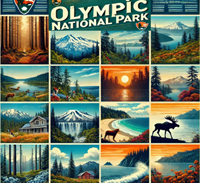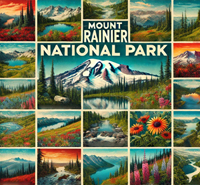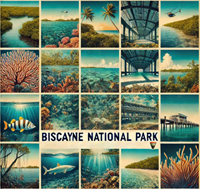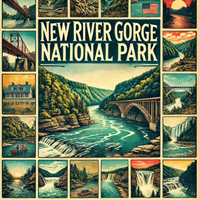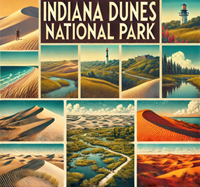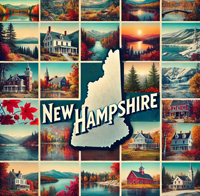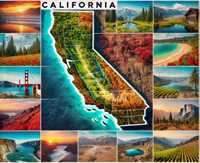
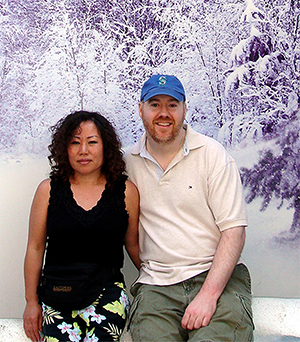
Embark on a journey curated by seasoned explorers William and Hui Cha Stanek, who have spent decades immersing themselves in the diverse landscapes of North America. These itineraries are more than just travel plans - they are thoughtfully crafted adventures designed to help you connect with the natural world, discover hidden gems, and create lasting memories.
National Parks Index | US Itineraries Index | American Roadtrips Index

Bring home a Bugville Critters book and watch as your child's love for reading and learning grows with every page. Hand-painted illustrations bring the heartwarming stories to life. Ask your librarian to add Bugville Critters to the library's digital collection today!
Discover William Stanek's Exclusive Art Collection
Explore and purchase the stunning art featured on this site. Own a piece of William Stanek's unique and captivating artwork today!
(May 2, 2025) Embracing the Desert's Mystique: Joshua Tree National Park and Mojave National Preserve
A 3-Day Adventure
Personal Story: William's First Encounter with the Magic of the Desert
The desert has always held a special place in my heart. There's something about the vast, open landscapes, the silence that stretches for miles, and the unique beauty that only a desert can offer. My first encounter with Joshua Tree National Park was one of those experiences that left an indelible mark on my soul. I remember standing in the middle of a vast expanse, surrounded by the park's namesake Joshua trees, with their twisted, alien-like forms reaching up toward the sky. The sun was setting, casting a golden glow over the landscape, and the quiet was almost deafening. It was in that moment that I felt the true magic of the desert – a place where time seems to stand still and nature's beauty takes on an almost otherworldly quality.
Not long after, I found myself in the Mojave National Preserve, another desert wonderland that offers a different kind of beauty. Here, the landscape is even more rugged, with towering sand dunes, volcanic cinder cones, and vast fields of Joshua trees stretching as far as the eye can see. The Mojave Desert is a place of extremes, where temperatures can soar during the day and plummet at night, and where the landscape changes dramatically with the shifting light. Together, Joshua Tree and Mojave offer a dual adventure that showcases the incredible diversity and beauty of the desert. In this guide, Hui Cha and I will take you through these two remarkable desert parks, sharing our favorite hikes, photography spots, and insider tips to help you make the most of your visit.
About Joshua Tree National Park
Joshua Tree National Park, located in southern California, is a desert wonderland known for its unique and striking landscapes. The park is named after the Joshua tree, a species of yucca that grows only in the Mojave Desert and is famous for its twisted, spiky branches. But Joshua Tree is much more than just its namesake trees. The park is home to vast desert plains, rugged mountains, hidden oases, and a fascinating array of rock formations that have made it a mecca for rock climbers and nature lovers alike. Whether you're exploring the Cholla Cactus Garden at sunrise, hiking through the Hidden Valley, or stargazing under some of the darkest skies in southern California, Joshua Tree offers a unique and unforgettable desert experience.
About Mojave National Preserve
Mojave National Preserve, located just north of Joshua Tree, is a vast expanse of desert wilderness that covers over 1.6 million acres of rugged and varied terrain. The preserve is home to some of the most iconic landscapes of the American Southwest, including the Kelso Dunes, the Cinder Cone Lava Beds, and the Joshua Tree Forest. But the Mojave is also a place of quiet solitude, where you can hike for miles without seeing another person, explore remote desert canyons, and experience the true beauty and isolation of the desert. The Mojave Desert is a land of extremes, where life has adapted to survive in one of the harshest environments on Earth. Whether you're climbing to the top of a sand dune, exploring a lava tube, or simply soaking in the silence of the desert, the Mojave National Preserve offers a truly unique and immersive desert experience.
Day 1: A Deep Dive into Joshua Tree National Park
Morning: Sunrise at Cholla Cactus Garden
6:00 AM - Start at Cholla Cactus Garden
Overview: Begin your adventure in Joshua Tree with a sunrise visit to the Cholla Cactus Garden, one of the park's most iconic and photogenic spots. The Cholla Cactus Garden is home to a dense concentration of cholla cacti, also known as "teddy bear" cacti for their soft appearance. But don't be fooled – these cacti are covered in sharp spines that can easily detach and embed in your skin. Despite their prickly nature, the cholla cacti are incredibly beautiful, especially at sunrise when the soft light makes their spines glow.
Tips from William: "The Cholla Cactus Garden is a photographer's paradise, especially at sunrise when the light is soft and golden. Bring a wide-angle lens to capture the vast expanse of cacti, and a macro lens for close-ups of the spines and flowers. The early morning light creates a beautiful glow that makes the cacti look almost otherworldly. But be careful – these cacti can be dangerous, so watch your step and don't get too close."
Insights from Hui Cha: "The Cholla Cactus Garden is located in the Pinto Basin, about 12 miles south of the park's north entrance. The garden is easily accessible from the road, with a short loop trail that takes you through the heart of the cacti. The trail is flat and easy, making it accessible to all visitors. But remember to wear sturdy shoes and watch your step – cholla spines are notoriously difficult to remove once they've embedded in your skin."
How to Access the Cholla Cactus Garden
Location: The Cholla Cactus Garden is located along Pinto Basin Road, about 12 miles south of the north entrance to Joshua Tree National Park.
Directions: From the Joshua Tree Visitor Center, head south on Park Boulevard for about 10 miles until you reach the junction with Pinto Basin Road. Turn left onto Pinto Basin Road and continue for about 2 miles until you reach the Cholla Cactus Garden on your left.
Trail Details: The Cholla Cactus Garden Trail is a short, easy loop that takes you through the heart of the garden. The trail is flat and well-maintained, with interpretive signs that provide information about the cacti and the surrounding desert ecosystem.
Photography Techniques:
-
Cactus Landscapes: Use a wide-angle lens to capture the expansive views of the Cholla Cactus Garden at sunrise. Look for compositions that include the cacti, mountains, and sky, and consider using a polarizing filter to enhance the colors and reduce glare.
-
Close-Ups of Cacti: The spines and flowers of the cholla cacti are perfect for close-up photography. Use a macro lens to capture the intricate details of the spines, and experiment with different depths of field to create interesting compositions.
-
Sunrise Glow: The early morning light creates a beautiful glow that makes the cholla cacti look almost otherworldly. Use a tripod to capture the soft light and the long shadows cast by the cacti, and experiment with different angles to find the best light.
Alternative Activity:
If you prefer a less spiny experience, consider starting your day with a sunrise hike to Arch Rock. This short, easy hike takes you to a beautiful natural rock arch that is especially photogenic in the early morning light. The trail is well-marked and suitable for all ages and fitness levels.
Mid-Morning: Exploring Hidden Valley
9:00 AM - Hike the Hidden Valley Trail
Overview: After your sunrise photography session, head to Hidden Valley, one of Joshua Tree's most popular and scenic hiking areas. Hidden Valley is a natural, enclosed valley surrounded by massive boulders and rocky outcroppings. The valley is believed to have been used by cattle rustlers in the 19th century, who would hide their stolen cattle in the secluded area. Today, Hidden Valley is a haven for hikers, rock climbers, and nature lovers, offering a unique and beautiful desert landscape to explore.
Tips from William: "Hidden Valley is a fantastic place to explore and photograph. The towering boulders and unique rock formations create endless opportunities for interesting compositions. Bring a wide-angle lens to capture the sweeping views of the valley, and a telephoto lens for close-ups of the rock formations and desert plants. The light is best in the morning and late afternoon when the shadows are long and the colors are warm."
Insights from Hui Cha: "The Hidden Valley Trail is a 1-mile loop that takes you through the heart of the valley. The trail is easy and well-maintained, making it accessible to all visitors. Along the way, you'll see a variety of desert plants, including Joshua trees, yuccas, and cacti, as well as interesting rock formations and beautiful views of the surrounding mountains. Take your time and explore the side trails and boulder fields – there's always something new to discover in Hidden Valley."
How to Access the Hidden Valley Trail
Location: The Hidden Valley Trailhead is located off Park Boulevard, about 14 miles south of the Joshua Tree Visitor Center.
Directions: From the Cholla Cactus Garden, return to Pinto Basin Road and head north for about 2 miles to the junction with Park Boulevard. Turn left onto Park Boulevard and continue for about 12 miles until you reach the signed turnoff for Hidden Valley. Follow the road to the parking area, where you'll find the trailhead.
Trail Details: The Hidden Valley Trail is a 1-mile loop that takes you through a beautiful, enclosed valley surrounded by massive boulders. The trail is easy and well-maintained, with interpretive signs that provide information about the area's natural and cultural history.
Photography Techniques:
-
Valley Landscapes: Use a wide-angle lens to capture the expansive views of Hidden Valley. Look for compositions that include the boulders, desert plants, and sky, and consider using a polarizing filter to enhance the colors and reduce glare.
-
Rock Formation Close-Ups: The boulders and rock formations in Hidden Valley are full of interesting textures and patterns. Use a telephoto lens to isolate details in the rock, and experiment with different angles to highlight the contrast between the rocks and the sky.
-
Desert Plants: The desert plants in Hidden Valley offer great opportunities for close-up photography. Use a macro lens to capture the intricate details of the Joshua trees, yuccas, and cacti, and experiment with different depths of field to create interesting compositions.
Alternative Activity:
If you're looking for a more challenging hike, consider exploring the nearby Barker Dam Trail. This 1.3-mile loop takes you to a historic dam and reservoir, offering beautiful views of the surrounding desert and interesting rock art along the way. The trail is moderately challenging, with some rocky sections, but the scenery is well worth the effort.
Afternoon: Exploring Keys View and Skull Rock
1:00 PM - Visit Keys View and Skull Rock
Overview: After your morning hike, take a scenic drive to Keys View, one of the highest viewpoints in Joshua Tree National Park. From Keys View, you'll have a panoramic view of the Coachella Valley, the San Andreas Fault, and the distant peaks of San Gorgonio and San Jacinto. After taking in the views, head to Skull Rock, a unique rock formation that resembles a human skull.
Tips from William: "Keys View offers some of the best panoramic views in Joshua Tree. The light in the early afternoon can be harsh, so consider using a polarizing filter to reduce glare and enhance the colors. Skull Rock is a fun and photogenic spot, especially for creative compositions. Bring a wide-angle lens to capture the entire formation, and don't be afraid to play with angles and perspectives."
Insights from Hui Cha: "Keys View is easily accessible by car, with a short walk from the parking area to the viewpoint. The views are absolutely stunning, especially on a clear day when you can see all the way to the Salton Sea. After visiting Keys View, head to Skull Rock, which is located just off Park Boulevard. The rock formation is right by the road, with a short trail that takes you around the area. It's a fun spot to explore and take photos, especially if you have kids with you."
How to Access Keys View and Skull Rock
Location: Keys View is located off Keys View Road, about 5 miles south of Park Boulevard. Skull Rock is located along Park Boulevard, about 3 miles northeast of the Joshua Tree Visitor Center.
Directions: From Hidden Valley, return to Park Boulevard and head west for about 3 miles to the junction with Keys View Road. Turn left onto Keys View Road and continue for about 5 miles to the parking area. After visiting Keys View, return to Park Boulevard and head northeast for about 8 miles to reach Skull Rock.
Exploration Details: Keys View is easily accessible by car, with a short walk from the parking area to the viewpoint. Skull Rock is located right by the road, with a short trail that takes you around the rock formation and offers different perspectives.
Photography Techniques:
-
Panoramic Views: Use a wide-angle lens to capture the expansive views from Keys View. Look for compositions that include the mountains, valley, and sky, and consider using a graduated neutral density filter to balance the exposure between the bright sky and the darker landscape.
-
Creative Compositions at Skull Rock: Skull Rock offers endless opportunities for creative compositions. Use a wide-angle lens to capture the entire formation, and experiment with different angles and perspectives to create interesting and fun photos.
-
Desert Landscapes: The area around Skull Rock is full of interesting rock formations and desert plants. Use a telephoto lens to isolate details in the landscape, and experiment with different depths of field to create a sense of depth and scale.
Alternative Activity:
If you prefer a more leisurely afternoon, consider exploring the nearby Oasis of Mara. This short, easy walk takes you through a historic oasis that has been used by Native Americans for thousands of years. The oasis is home to a variety of desert plants and wildlife, and the walk is peaceful and serene.
Evening: Stargazing at Joshua Tree
8:00 PM - Stargazing at Joshua Tree National Park
Overview: End your day with a stargazing session at Joshua Tree National Park, one of the best places in southern California for viewing the night sky. The park's remote location and lack of light pollution make it an ideal spot for stargazing, with clear, dark skies that reveal the Milky Way and countless stars. The area around Cap Rock is a popular spot for stargazing, offering unobstructed views of the night sky.
Tips from William: "Stargazing at Joshua Tree is a truly magical experience. The desert sky is incredibly clear, and the stars seem to stretch on forever. Bring a telescope or binoculars for a closer look at the planets and stars, and use a tripod for long-exposure photography if you're capturing the night sky."
Insights from Hui Cha: "The night sky at Joshua Tree is something special. The quiet of the desert, combined with the brilliance of the stars, creates a peaceful and contemplative atmosphere. Bring a blanket and a warm drink, and take your time soaking in the beauty of the universe."
How to Access Cap Rock
Location: Cap Rock is located along Park Boulevard, about 12 miles south of the Joshua Tree Visitor Center.
Directions: From Skull Rock, return to Park Boulevard and head southwest for about 12 miles to reach Cap Rock. The area is well-marked, with parking available near the rock formation.
Stargazing Details: Cap Rock offers unobstructed views of the night sky, with little light pollution and clear skies. The area is popular for stargazing, with plenty of space to spread out and enjoy the stars.
Photography Techniques:
-
Milky Way Photography: The Milky Way is often visible from Joshua Tree, especially in the summer months. Use a fast lens (f/2.8 or faster) and a high ISO setting to capture the detail of the Milky Way, and include the surrounding landscape in your composition for added context.
-
Star Trails: Use a wide-angle lens and a tripod to capture long-exposure shots of star trails. Experiment with different shutter speeds to create dramatic patterns in the sky.
-
Nightscapes: The clear air at Joshua Tree makes for excellent nightscape photography. Use a tripod and a remote shutter release to capture sharp, detailed images of the stars and the surrounding landscape.
Alternative Activity:
If you prefer a more structured stargazing experience, consider attending one of the park's ranger-led astronomy programs. These programs are offered during the summer months and provide a guided tour of the night sky, with telescopes and other equipment available for public use.
Day 2: The Rugged Beauty of Mojave National Preserve
Morning: Sunrise at Kelso Dunes
6:00 AM - Start at Kelso Dunes Trailhead
Overview: Begin your second day with a sunrise hike to the top of the Kelso Dunes, one of the most iconic and impressive features of the Mojave National Preserve. The Kelso Dunes rise up to 650 feet above the desert floor, offering stunning views of the surrounding landscape. The hike to the top is challenging, but the reward is well worth the effort – especially at sunrise when the light is soft and the shadows are long.
Tips from William: "The Kelso Dunes are a must-see in the Mojave. The early morning light is perfect for photography, with the long shadows creating a beautiful play of light and dark across the dunes. Bring a wide-angle lens to capture the sweeping views from the top, and a telephoto lens for close-ups of the patterns in the sand. The hike can be strenuous, especially in the soft sand, so take your time and enjoy the journey."
Insights from Hui Cha: "The hike to the top of the Kelso Dunes is about 3 miles round trip, with an elevation gain of 650 feet. The soft sand makes the hike challenging, but the views from the top are absolutely stunning. The dunes are constantly shifting with the wind, creating new patterns and shapes every day. Take your time to explore the area and listen for the 'singing' of the dunes – a low, rumbling sound that occurs when the sand moves."
How to Access the Kelso Dunes Trailhead
Location: The Kelso Dunes are located off Kelso Dunes Road, about 7 miles west of Kelbaker Road.
Directions: From the Joshua Tree Visitor Center, head northeast on Park Boulevard to reach Highway 62. Follow Highway 62 east to the town of Twentynine Palms, then take Amboy Road north to reach Kelbaker Road. Continue north on Kelbaker Road for about 30 miles until you reach the signed turnoff for Kelso Dunes Road. Follow the road to the parking area, where you'll find the trailhead.
Trail Details: The hike to the top of the Kelso Dunes is about 3 miles round trip, with an elevation gain of 650 feet. The trail is not marked, but the dunes are visible from the parking area, and you can choose your own path to the top. The hike is challenging due to the soft sand, but the views from the top are well worth the effort.
Photography Techniques:
-
Dune Landscapes: Use a wide-angle lens to capture the expansive views of the Kelso Dunes. Look for compositions that include the curves and ridges of the dunes, as well as the surrounding desert and sky.
-
Sand Patterns: The patterns in the sand are perfect for close-up photography. Use a telephoto lens to isolate details in the sand, and experiment with different depths of field to create interesting compositions.
-
Sunrise Colors: The early morning light creates beautiful colors and shadows on the dunes. Use a tripod to capture the soft light and the long shadows, and experiment with different exposures to find the best balance between light and dark.
Alternative Activity:
If the hike to the top of the dunes feels too challenging, consider exploring the nearby Kelso Depot Visitor Center instead. This historic train depot has been beautifully restored and now serves as a visitor center and museum, offering exhibits on the history and natural features of the Mojave Desert.
Mid-Morning: Exploring the Lava Tube
9:30 AM - Visit the Mojave Lava Tube
Overview: After your morning hike, head to the Mojave Lava Tube, a fascinating geological feature located in the heart of the Mojave Desert. The lava tube was formed by ancient volcanic activity and offers a unique opportunity to explore the underground world of the desert. The lava tube is relatively short, but the experience of walking through the dark, cool tunnel and seeing the light beams filtering through the holes in the ceiling is unforgettable.
Tips from William: "The Mojave Lava Tube is a hidden gem in the preserve. The light beams that filter through the holes in the ceiling create beautiful, otherworldly scenes that are perfect for photography. Bring a tripod and a wide-angle lens to capture the light beams and the textures of the lava walls. A flashlight or headlamp is also essential for navigating the dark tunnel."
Insights from Hui Cha: "The hike to the lava tube is short and easy, but the experience of exploring the tube is truly unique. The tube is about 1,000 feet long, with several holes in the ceiling that allow light to filter in. The best time to visit is in the late morning when the sun is high enough to create the light beams. The temperature inside the tube is cool, making it a great place to escape the heat of the day."
How to Access the Mojave Lava Tube
Location: The Mojave Lava Tube is located off Aiken Mine Road, about 5 miles north of Kelbaker Road.
Directions: From the Kelso Dunes, return to Kelbaker Road and head north for about 5 miles until you reach the signed turnoff for Aiken Mine Road. Follow the dirt road for about 5 miles until you reach the parking area for the lava tube. The road can be rough in places, so a high-clearance vehicle is recommended.
Exploration Details: The hike to the Mojave Lava Tube is short and easy, with a well-marked trail that leads to the entrance of the tube. The tube is about 1,000 feet long, with several holes in the ceiling that allow light to filter in. A flashlight or headlamp is essential for navigating the dark tunnel.
Photography Techniques:
-
Light Beams: The light beams that filter through the holes in the ceiling create beautiful, otherworldly scenes. Use a wide-angle lens and a tripod to capture the beams and the textures of the lava walls. Experiment with different exposures to find the best balance between light and dark.
-
Lava Wall Textures: The walls of the lava tube are full of interesting textures and patterns. Use a macro or telephoto lens to capture the details of the lava, and experiment with different angles to highlight the contrast between light and shadow.
-
Exploring the Tube: The experience of exploring the lava tube is unique and can be captured with a wide-angle lens. Look for compositions that include the entrance to the tube, the light beams, and the surrounding desert landscape.
Alternative Activity:
If you prefer to stay above ground, consider exploring the nearby Hole-in-the-Wall Rings Trail. This short, but challenging hike takes you through a narrow canyon filled with unusual rock formations and ancient petroglyphs. The trail is well-marked and suitable for experienced hikers, with some sections requiring the use of metal rings embedded in the rock to climb.
Afternoon: Exploring the Cinder Cone Lava Beds and Teutonia Peak Trail
1:00 PM - Visit the Cinder Cone Lava Beds and Hike the Teutonia Peak Trail
Overview: After exploring the lava tube, head to the Cinder Cone Lava Beds, a fascinating area of volcanic activity that offers a unique landscape of dark, rocky terrain. The area is home to several cinder cones, as well as the Teutonia Peak Trail, which takes you to the summit of Teutonia Peak for stunning views of the surrounding desert and the largest Joshua tree forest in the world.
Tips from William: "The Cinder Cone Lava Beds offer a stark contrast to the rest of the Mojave Desert. The dark, rocky terrain is full of interesting textures and patterns that are perfect for photography. The hike to Teutonia Peak is moderately challenging but offers some of the best views in the preserve. Bring a wide-angle lens to capture the expansive views from the top, and a polarizing filter to enhance the colors and reduce glare."
Insights from Hui Cha: "The Teutonia Peak Trail is about 3 miles round trip, with a moderate ascent to the summit. The trail takes you through a unique landscape of volcanic rock and Joshua trees, offering beautiful views of the surrounding desert. The summit of Teutonia Peak is a great place to take in the vastness of the Mojave Desert, with the dark cinder cones contrasting against the bright desert floor."
How to Access the Cinder Cone Lava Beds and Teutonia Peak Trail
Location: The Cinder Cone Lava Beds are located along Kelbaker Road, about 15 miles north of the Kelso Depot Visitor Center. The Teutonia Peak Trailhead is located just off Kelbaker Road, near the lava beds.
Directions: From the Mojave Lava Tube, return to Aiken Mine Road and head south to Kelbaker Road. Turn left onto Kelbaker Road and continue for about 15 miles until you reach the signed turnoff for the Teutonia Peak Trailhead.
Trail Details: The hike to Teutonia Peak is about 3 miles round trip, with a moderate ascent to the summit. The trail is well-marked and takes you through a unique landscape of volcanic rock and Joshua trees. The summit offers stunning views of the surrounding desert and the Cinder Cone Lava Beds.
Photography Techniques:
-
Volcanic Landscapes: Use a wide-angle lens to capture the expansive views of the Cinder Cone Lava Beds and the surrounding desert. Look for compositions that include the cinder cones, Joshua trees, and sky, and consider using a polarizing filter to enhance the colors and contrast.
-
Joshua Tree Close-Ups: The Joshua trees in the Teutonia Peak area are some of the largest and oldest in the Mojave Desert. Use a telephoto lens to isolate details in the trees, and experiment with different angles to highlight the contrast between the trees and the volcanic rock.
-
Panoramic Views: The summit of Teutonia Peak offers sweeping views of the Mojave Desert. Use a tripod and a panoramic head to capture the full sweep of the landscape, including the cinder cones, desert floor, and distant mountains.
Alternative Activity:
If the hike to Teutonia Peak feels too challenging, consider exploring the nearby Kelso Depot Visitor Center instead. This historic train depot has been beautifully restored and now serves as a visitor center and museum, offering exhibits on the history and natural features of the Mojave Desert.
Evening: Sunset at Hole-in-the-Wall
6:30 PM - Sunset at Hole-in-the-Wall
Overview: Conclude your second day with a peaceful sunset at Hole-in-the-Wall, one of the most unique and scenic areas of the Mojave National Preserve. Hole-in-the-Wall is known for its unusual rock formations, which are full of holes and caves formed by ancient volcanic activity. The area is especially beautiful at sunset when the rocks take on a warm, golden glow.
Tips from William: "Hole-in-the-Wall is a fantastic spot for sunset photography. The unique rock formations and the warm, golden light create stunning compositions. Bring a wide-angle lens to capture the expansive views, and a tripod for long exposures. The light is best in the late afternoon and early evening, so take your time and explore the area before the sun sets."
Insights from Hui Cha: "The Hole-in-the-Wall area is easily accessible by car, with several short trails that take you through the heart of the rock formations. The rocks are full of interesting textures and patterns, and the light at sunset is perfect for photography. After exploring the area, find a quiet spot to sit and watch the sun set over the desert – it's a peaceful and beautiful way to end the day."
How to Access Hole-in-the-Wall
Location: Hole-in-the-Wall is located off Black Canyon Road, about 20 miles southeast of the Kelso Depot Visitor Center.
Directions: From the Cinder Cone Lava Beds, return to Kelbaker Road and head south to Black Canyon Road. Follow Black Canyon Road southeast for about 20 miles until you reach the signed turnoff for Hole-in-the-Wall. The area is well-marked, with parking available near the rock formations.
Exploration Details: Hole-in-the-Wall is easily accessible by car, with several short trails that take you through the heart of the rock formations. The area is full of interesting textures and patterns, making it a perfect spot for photography. The best time to visit is in the late afternoon and early evening when the rocks are bathed in warm, golden light.
Photography Techniques:
-
Rock Formations: Use a wide-angle lens to capture the unique rock formations at Hole-in-the-Wall. Look for compositions that include the holes and caves, as well as the surrounding desert and sky.
-
Sunset Colors: The warm, golden light at sunset creates beautiful colors and shadows on the rocks. Use a tripod to capture the soft light and the long shadows, and experiment with different exposures to find the best balance between light and dark.
-
Close-Ups of Rock Textures: The rocks at Hole-in-the-Wall are full of interesting textures and patterns. Use a macro or telephoto lens to capture the details of the rock, and experiment with different angles to highlight the contrast between light and shadow.
Alternative Activity:
If you prefer a more elevated view, consider driving up to the nearby Wild Horse Mesa for sunset. The views from the mesa are expansive, offering a wide perspective of the surrounding desert and mountains. It's a great spot for panoramic photography and reflection.
Day 3: A Final Day of Discovery in Joshua Tree and Mojave
Morning: Exploring the Lost Palms Oasis Trail
7:00 AM - Hike the Lost Palms Oasis Trail
Overview: Start your final day with a hike to the Lost Palms Oasis, one of the most beautiful and secluded spots in Joshua Tree National Park. The Lost Palms Oasis is a hidden gem, with a lush grove of fan palms surrounded by rugged desert terrain. The hike is moderately challenging but offers stunning views of the surrounding desert and the opportunity to explore a true desert oasis.
Tips from William: "The Lost Palms Oasis is a perfect example of the beauty and diversity of the desert. The contrast between the lush palms and the surrounding desert is striking, and the hike to the oasis offers plenty of opportunities for photography. Bring a wide-angle lens to capture the expansive views of the desert, and a telephoto lens for close-ups of the palms and the surrounding landscape. The light is best in the morning, so start early to avoid the heat and capture the best photos."
Insights from Hui Cha: "The hike to Lost Palms Oasis is about 7.5 miles round trip, with some steep sections and rocky terrain. The trail is well-marked and takes you through a variety of desert landscapes, including rocky canyons, sandy washes, and open plains. The oasis itself is a beautiful and peaceful spot, with plenty of shade and cool, refreshing water. Take your time to explore the area and enjoy the serenity of the oasis – it's a perfect place to relax and recharge."
How to Access the Lost Palms Oasis Trail
Location: The Lost Palms Oasis Trailhead is located at the Cottonwood Spring Oasis, near the south entrance to Joshua Tree National Park.
Directions: From the Joshua Tree Visitor Center, head south on Park Boulevard to reach Highway 62. Follow Highway 62 east to the town of Twentynine Palms, then take Pinto Basin Road south to the Cottonwood Spring Oasis. The trailhead is located near the oasis, with parking available.
Trail Details: The hike to Lost Palms Oasis is about 7.5 miles round trip, with some steep sections and rocky terrain. The trail is well-marked and takes you through a variety of desert landscapes, including rocky canyons, sandy washes, and open plains. The oasis is a beautiful and secluded spot, with a lush grove of fan palms and plenty of shade.
Photography Techniques:
-
Desert Landscapes: Use a wide-angle lens to capture the expansive views of the desert along the Lost Palms Oasis Trail. Look for compositions that include the trail, desert plants, and sky, and consider using a polarizing filter to enhance the colors and reduce glare.
-
Oasis Close-Ups: The fan palms at Lost Palms Oasis are perfect for close-up photography. Use a telephoto lens to isolate details in the palms, and experiment with different depths of field to create interesting compositions.
-
Rocky Canyons: The rocky canyons along the trail offer great opportunities for landscape photography. Use a wide-angle lens to capture the dramatic scenery, and experiment with different angles to highlight the contrast between the rocks and the sky.
Alternative Activity:
If the hike to Lost Palms Oasis feels too long or challenging, consider exploring the shorter and easier Mastodon Peak Loop Trail instead. This 2.6-mile loop takes you to the summit of Mastodon Peak, offering beautiful views of the surrounding desert and the opportunity to explore a historic gold mine along the way.
Mid-Morning: Visiting the Joshua Tree Visitor Center and Keys Ranch
10:30 AM - Visit the Joshua Tree Visitor Center and Keys Ranch
Overview: After your morning hike, head to the Joshua Tree Visitor Center to learn more about the park's natural and cultural history. The visitor center offers exhibits, maps, and information about the park, as well as a gift shop and restrooms. After visiting the center, take a guided tour of Keys Ranch, a historic homestead that offers a fascinating glimpse into the history of the area.
Tips from William: "The Joshua Tree Visitor Center is a great place to learn more about the park and its unique desert ecosystem. The exhibits are informative and well-curated, offering insights into the geology, flora, and fauna of the area. The Keys Ranch tour is a must-do for history buffs, offering a fascinating look at life in the desert during the early 20th century. Bring a camera to capture the historic buildings and the beautiful desert landscape surrounding the ranch."
Insights from Hui Cha: "The Keys Ranch tour is one of the highlights of Joshua Tree. The tour is led by knowledgeable rangers who provide a wealth of information about the history of the area and the people who lived there. The ranch itself is beautifully preserved, with original buildings, tools, and artifacts that offer a unique glimpse into the past. The tour is limited to small groups, so it's a good idea to book your tickets in advance."
How to Access the Joshua Tree Visitor Center and Keys Ranch
Location: The Joshua Tree Visitor Center is located in the town of Joshua Tree, near the west entrance to the park. Keys Ranch is located within the park, near the Hidden Valley area.
Directions: From the Lost Palms Oasis Trail, return to Pinto Basin Road and head north to the Joshua Tree Visitor Center. The visitor center is located just off Park Boulevard, with parking available. The Keys Ranch tour begins at the Keys Ranch parking area, which is located near the Hidden Valley area of the park.
Exploration Details: The Joshua Tree Visitor Center offers exhibits, maps, and information about the park, as well as a gift shop and restrooms. The Keys Ranch tour is a guided, 90-minute tour that takes you through the historic homestead and offers a fascinating look at the history of the area.
Photography Techniques:
-
Historic Buildings: Use a wide-angle lens to capture the historic buildings at Keys Ranch. Look for compositions that include the buildings, desert landscape, and sky, and consider using a polarizing filter to enhance the colors and reduce glare.
-
Desert Plants: The area around Keys Ranch is full of interesting desert plants, including Joshua trees, yuccas, and cacti. Use a macro lens to capture the intricate details of the plants, and experiment with different depths of field to create interesting compositions.
-
Cultural Artifacts: The tools and artifacts at Keys Ranch offer great opportunities for close-up photography. Use a telephoto or macro lens to capture the details of the historic objects, and experiment with different angles to highlight the contrast between the artifacts and the surrounding landscape.
Alternative Activity:
If you prefer a more natural experience, consider exploring the nearby Hidden Valley Nature Trail instead. This 1-mile loop takes you through a beautiful, enclosed valley surrounded by massive boulders and rock formations, offering a peaceful and scenic hike with plenty of opportunities for photography.
Afternoon: Scenic Drive to Amboy Crater
1:00 PM - Drive to Amboy Crater
Overview: After exploring the visitor center and Keys Ranch, take a scenic drive to Amboy Crater, a dormant volcanic cinder cone located in the heart of the Mojave Desert. Amboy Crater is a fascinating geological feature, offering a unique landscape of dark volcanic rock and a stunning contrast to the surrounding desert. The hike to the top of the crater is short but challenging, offering beautiful views of the surrounding desert and the opportunity to explore the inside of the crater.
Tips from William: "Amboy Crater is one of the most unique and photogenic spots in the Mojave Desert. The contrast between the dark volcanic rock and the bright desert floor creates stunning compositions, especially in the late afternoon light. Bring a wide-angle lens to capture the expansive views from the top of the crater, and a telephoto lens for close-ups of the volcanic rock. The hike can be challenging, especially in the heat, so bring plenty of water and take your time."
Insights from Hui Cha: "The hike to the top of Amboy Crater is about 3 miles round trip, with a steep ascent to the summit. The trail is well-marked, but the volcanic rock can be rough and uneven, so wear sturdy shoes and watch your step. The views from the top are absolutely stunning, with the dark crater contrasting against the bright desert floor. After exploring the crater, take some time to relax and enjoy the solitude of the desert – it's a peaceful and beautiful place to reflect on your journey."
How to Access Amboy Crater
Location: Amboy Crater is located off Historic Route 66, about 30 miles west of the town of Needles, California.
Directions: From Keys Ranch, return to Park Boulevard and head east to reach Highway 62. Follow Highway 62 east to the town of Twentynine Palms, then take Amboy Road north to reach Historic Route 66. Follow Route 66 west for about 15 miles until you reach the signed turnoff for Amboy Crater. The parking area is well-marked, with restrooms and picnic tables available.
Trail Details: The hike to the top of Amboy Crater is about 3 miles round trip, with a steep ascent to the summit. The trail is well-marked, but the volcanic rock can be rough and uneven, so wear sturdy shoes and bring plenty of water. The views from the top are stunning, with the dark crater contrasting against the bright desert floor.
Photography Techniques:
-
Volcanic Landscapes: Use a wide-angle lens to capture the expansive views of Amboy Crater and the surrounding desert. Look for compositions that include the crater, desert floor, and sky, and consider using a polarizing filter to enhance the colors and reduce glare.
-
Rocky Terrain: The volcanic rock at Amboy Crater offers great opportunities for close-up photography. Use a telephoto or macro lens to capture the details of the rock, and experiment with different depths of field to create interesting compositions.
-
Desert Views: The views from the top of Amboy Crater are perfect for landscape photography. Use a tripod and a wide-angle lens to capture the sweeping views of the desert, and experiment with different angles to highlight the contrast between the dark crater and the bright desert floor.
Alternative Activity:
If the hike to Amboy Crater feels too challenging, consider exploring the nearby Bagdad Caf� instead. This historic roadside diner, located along Route 66, is a famous landmark and a great place to stop for a meal or a photo opportunity.
Evening: Sunset at Joshua Tree
6:30 PM - Sunset at Joshua Tree National Park
Overview: Conclude your adventure with a peaceful sunset at Joshua Tree National Park, one of the most beautiful and serene spots in southern California. The park's unique landscape of twisted Joshua trees, massive boulders, and open desert is especially beautiful at sunset when the light is soft and the shadows are long. The area around Keys View or Hidden Valley is a perfect spot to watch the sun set and reflect on your journey.
Tips from William: "Sunset at Joshua Tree is a truly magical experience. The soft, golden light creates beautiful compositions, with the Joshua trees and boulders casting long shadows across the desert floor. Bring a tripod for long exposures, and experiment with different angles to capture the best light and shadows. The light is best in the late afternoon and early evening, so take your time and enjoy the beauty of the desert as the sun sets."
Insights from Hui Cha: "The sunset at Joshua Tree is one of the highlights of the park. The light at this time of day is perfect for photography, with the warm colors and long shadows creating a peaceful and serene atmosphere. After the sun sets, take some time to stargaze – the night sky at Joshua Tree is incredibly clear, with countless stars visible on a clear night. It's a perfect way to end your adventure in the desert."
How to Access Keys View and Hidden Valley
Location: Keys View and Hidden Valley are both located along Park Boulevard, within Joshua Tree National Park.
Directions: From Amboy Crater, return to Historic Route 66 and head east to Amboy Road. Follow Amboy Road south to the town of Twentynine Palms, then take Park Boulevard into Joshua Tree National Park. Follow Park Boulevard west to reach Keys View or Hidden Valley.
Exploration Details: Keys View and Hidden Valley are both easily accessible by car, with parking available near the viewpoints. The best time to visit is at sunset when the light is soft and the shadows are long.
Photography Techniques:
-
Sunset Landscapes: Use a wide-angle lens to capture the expansive views of Joshua Tree at sunset. Look for compositions that include the Joshua trees, boulders, and sky, and consider using a graduated neutral density filter to balance the exposure between the bright sky and the darker landscape.
-
Long Exposures: The soft light of sunset is perfect for long-exposure photography. Use a tripod and a slow shutter speed to capture the subtle colors and patterns in the sky, and experiment with different compositions to create a sense of depth.
-
Silhouettes and Reflections: The Joshua trees and boulders at sunset make for dramatic silhouettes against the colorful sky. Experiment with different angles to capture the reflections of the sunset in the surrounding landscape.
Alternative Activity:
If you prefer a more elevated view, consider driving up to the nearby Eureka Peak for sunset. The views from the peak are expansive, offering a wide perspective of the surrounding desert and mountains. It's a great spot for panoramic photography and reflection.
Conclusion: The Desert's Endless Allure
Personal Reflection: Hui Cha's Closing Thoughts on Joshua Tree and Mojave
As our journey through Joshua Tree National Park and Mojave National Preserve comes to an end, I find myself reflecting on the incredible beauty and diversity of these desert landscapes. The stark, rugged terrain of the desert has a way of stripping away the distractions of everyday life, leaving you with a deep sense of peace and connection to the natural world.
Joshua Tree, with its twisted trees, massive boulders, and open desert, offers a unique and otherworldly beauty that captivates the soul. The park's quiet, contemplative atmosphere invites you to slow down and appreciate the small details – the way the light plays on the rocks, the delicate blooms of desert flowers, the distant call of a coyote.
Mojave, with its vast, untamed wilderness, offers a different kind of beauty – a beauty that is raw, powerful, and awe-inspiring. The preserve's towering dunes, volcanic landscapes, and ancient Joshua trees create a landscape that feels both timeless and eternal, a place where you can lose yourself in the vastness of the desert and find a deeper connection to the Earth.
Whether you're drawn to the quiet beauty of Joshua Tree or the rugged majesty of Mojave, these desert parks offer something for every adventurer. Take the time to explore, to listen, and to immerse yourself in the beauty of these incredible landscapes. Every sunrise, every hike, every quiet moment in the desert is a part of the adventure, a part of the story that you'll carry with you long after you've left these parks behind.
Next Steps: Continuing Your Exploration
With Joshua Tree and Mojave behind you, the possibilities for further exploration are endless. Whether you choose to continue your journey through the deserts of the Southwest, explore the mountains and valleys of California, or venture further afield to discover more of America's national parks, remember to take the time to connect with each place you visit. Every park, every landscape has its own story to tell, and the more you listen, the richer your journey will be.
Happy adventuring!

Step into a world of timeless beauty with our premium, oversized hardcover book - crafted for discerning collectors and anyone who values the power of art. Perfect for your coffee table, it's more than just a book; it's a conversation starter, a window into over 30 years of William's visionary photography.
Your Support Matters
Purchasing artwork from William Stanek's collection not only brings beauty into your life but also helps us continue to share. Thank you for supporting our creative journey!

Support The Lights of Paris by Robert Stanek, William Stanek's pen name! Through vivid historical detail and deeply moving character stories, Robert takes readers on an unforgettable journey through one of history’s most transformative times.


